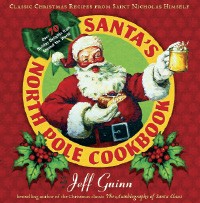Jeff Guinn is a man who created a world around Santa Claus. Where most of us see a mythical gift-giving saint (or, for the more cynical, a way-overdone marketing scheme), Guinn saw an amazing story as well as a career path.
First, there was Guinn’s book The Autobiography of Santa Claus, which traces the reality of Saint Nicholas (born 280 AD) and the development of the legend surrounding him. Next up was How Mrs. Claus Saved Christmas, which fictionalizes actual events of 17th-century England, when peasants marched to save Christmas from the Puritans, who had deemed it sinfully pagan. In that tome, Guinn turns a great literary trick, combining the origins of the candy cane and Oliver Cromwell in the same book.
And finally there was The Great Santa Search, in which Saint Nick descends from the North Pole to defend Christmas from the tide of commercialism.
Guinn, a native of Fort Worth, Texas, and author of several non-Christmas books, says that since food was always part of Christmas, his books always included some fabulous feasts — and readers wanted the recipes. This led Guinn on another research trip.
“It became obvious that to really understand Christmas history all over the world, you should look at the traditional foods people use to celebrate,” he says. The result is Santa’s North Pole Cookbook (Tacher), which Guinn will be touring to publicize this month. He’ll be at Davis-Kidd on Tuesday, December 11th.
Guinn confesses he had no idea what he was getting into with a cookbook.
“I started out wondering if I could find two dozen Christmas recipes from around the world,” he says. “I wound up with just under 400 of them. We had some huge tasting parties over the last two years.”
He settled on 75 recipes, and he’s brought the formula from his “Christmas Chronicles” into the kitchen: do the research then lay out stories and facts to expand your knowledge of Christmas. He says 85 percent of the recipes are taken straight from traditions of specific countries, while a chef friend, who appears as Santa’s private chef Lars, has created some “North Pole specialties.”
“I don’t claim to be in any sense a gourmet chef,” Guinn says, “but I am one of those people who enjoys getting into kitchen and trying to make things. We have a good mix of recipes to challenge world-class chefs and also to be fun for families to prepare together. I wanted to make sure everything in the book could be done at home.”

Among the five breakfasts, six breads, nine appetizers, 16 entrées, nine sides, six drinks, and over a dozen desserts, you’ll find little historical notes like where the word “Christmas” comes from and how turkeys get their name.
Some recipes didn’t make it. “Some things, after four or five tries, we finally decided that’s just the way it tastes,” Guinn admits.
Much of what made it won’t strike you as traditional Christmas fare, unless you’ve done Christmas in, say, Italy.
“In Italy, a lot of people were poor and seafood was readily available, so a lot of Christmas dishes feature some kind of seafood,” Guinn says. He’s given us a recipe for capitone fritto, or fried eel.
Can’t find eel in town? There’s also doro wat, an Ehtiopian chicken stew with cardamom, nutmeg, and ginger root. And there’s the Greek christopsomo (Christ’s bread), a raisin-walnut concoction that kids decorate. From Egypt, there are sweet cookies also enjoyed by Muslims.
There is — gasp! — a fruitcake recipe, as well as the story of fruitcake.
“Fruitcake was originally a road food for armies that would could keep forever,” Guinn explains. “Egyptian pharaohs loved it so much that for a while it was illegal for common people to eat it.”
His book has a recipe for “Black Christmas Fruitcake” from Trinidad and Tobago, whose complicated preparation is part of the festivities.
You’ll also find out that there are no plums in plum pudding; rather, the name comes from putting all the ingredients in a bag and boiling them until they expanded to “plum fill” the bag. Guinn’s recipe has 14 ingredients.
And you’ll learn that “palascinta,” or lemony Hungarian pancakes, were thought to be flown in by Jesus and a band of angels.
“I want to expand your Christmas knowledge while expanding your waistline,” Guinn jokes. “The most wonderful thing for me is realizing Christmas really is global. The means by which Saint Nick delivers his presents change, but everybody at some point sits down to the table and has a big feast.”
Jeff Guinn and “Lars” talk cooking, sign copies of Santa’s North Pole Cookbook, and offer baked goods at Davis-Kidd Booksellers on Tuesday, December 11th, at 5:30 p.m.

